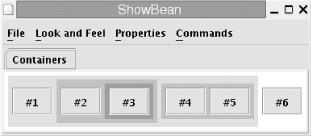Containers
The second step in creating a GUI is to place the
components you have created and configured into appropriate
containers. Chapter 2 of
Java Foundation Classes in a Nutshell contains
tables that list the container classes available in the AWT and Swing
packages. Many of these container classes have specialized uses.
JFrame is a top-level window, for
example, and JTabbedPane displays
the components it contains in individual tabbed panes (like those
pictured in Figure 11-1)
but Swing and the AWT also define generic container classes, such as
JPanel.
Example 11-1
is a listing of Containers.java. This class is a
subclass of JPanel. Its constructor
method creates a number of other nested JPanel instances, as well as a number of
JButton objects contained by those
JPanel classes. Example 11-1 illustrates the
concept of the containment hierarchy of a GUI, using color to
represent the nesting depth of the hierarchy. Figure 11-2 shows what the
Containers class looks like when
displayed with the ShowBean program
as follows:
% java je3.gui.ShowBean je3.gui.Containers

Figure 11-2. Nested containers
Example 11-1. Containers.java
package je3.gui; import javax.swing.*; import java.awt.*; /** * A component subclass that demonstrates nested containers and components. * It creates the hierarchy shown below, and uses different colors to * distinguish the different nesting levels of the ...
Get Java Examples in a Nutshell, 3rd Edition now with the O’Reilly learning platform.
O’Reilly members experience books, live events, courses curated by job role, and more from O’Reilly and nearly 200 top publishers.

